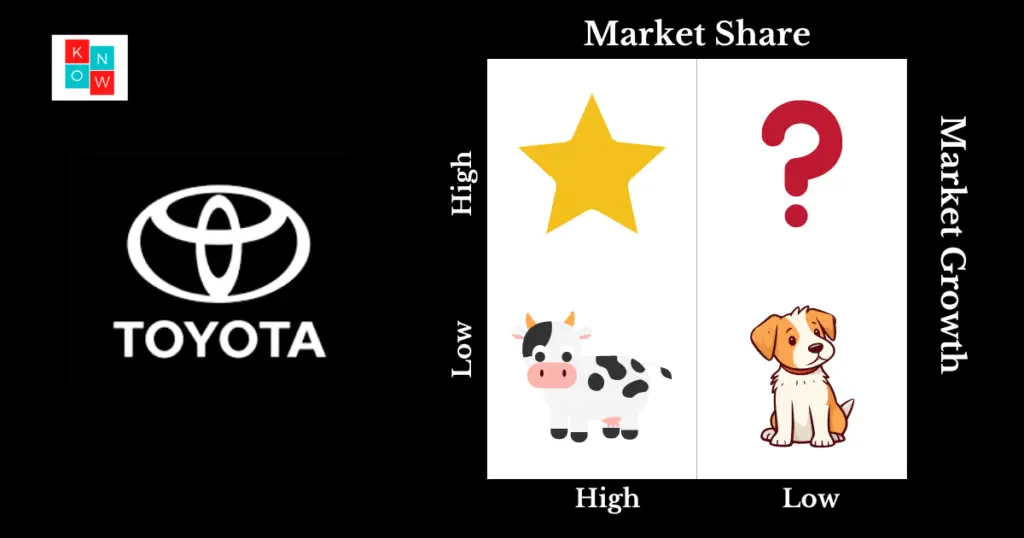BCG Matrix of Toyota
The Boston Consulting Group (BCG) Matrix is a strategic tool used to assess the position of a company’s products in terms of market share and growth potential. It categorizes products into four quadrants: Stars, Cash Cows, Question Marks, and Dogs. This analysis helps companies allocate resources efficiently and develop strategies for each product. In this blog, we’ll delve into Toyota’s product portfolio using the BCG Matrix.
Understanding the BCG Matrix
- Stars: High market share in high-growth markets. These products generate substantial revenue but also require significant investment to maintain their position and capitalize on growth opportunities.
- Cash Cows: High market share in low-growth markets. These products generate consistent, high profits with minimal investment, providing the cash needed to support other business areas.
- Question Marks: Low market share in high-growth markets. These products require significant investment to increase market share but are uncertain in their potential to become Stars or decline to Dogs.
- Dogs: Low market share in low-growth markets. These products typically drain resources and are often candidates for divestment or discontinuation.

Toyota’s Product Portfolio
Toyota, a global automotive leader, has a diverse product range spanning various market segments. We’ll categorize some of Toyota’s key models into the BCG Matrix quadrants to understand their strategic positions.
BCG Matrix of Toyota

Stars
Toyota Corolla
- Market Share: The Corolla has consistently been one of the best-selling cars worldwide.
- Market Growth: The compact car market, particularly in developing regions, shows steady growth.
- Analysis: The Corolla is a star in Toyota’s portfolio, benefiting from strong brand recognition, reliability, and affordability. Continuous investment in technology and design ensures it remains competitive.
Toyota RAV4
- Market Share: The RAV4 is one of the best-selling SUVs globally.
- Market Growth: The SUV segment is experiencing robust growth, driven by consumer preferences for spacious and versatile vehicles.
- Analysis: The RAV4, with its hybrid variants, stands out in a crowded market. Toyota’s focus on innovation and sustainability helps maintain its strong position.
Cash Cows
Toyota Camry
- Market Share: The Camry has a dominant presence in the midsize sedan market, especially in North America.
- Market Growth: The midsize sedan segment is mature, with limited growth.
- Analysis: The Camry generates substantial profits with relatively low investment needs. Its reputation for reliability and comfort ensures steady demand.
Toyota Hilux
- Market Share: The Hilux is a leading name in the global pickup truck market.
- Market Growth: The pickup truck market is stable, with moderate growth in certain regions.
- Analysis: The Hilux is a cash cow, particularly in markets like Australia and Southeast Asia, known for its durability and performance.
Question Marks
Toyota Mirai
- Market Share: The Mirai, a hydrogen fuel cell vehicle, has a small market share.
- Market Growth: The hydrogen vehicle market is in its early stages, with high growth potential.
- Analysis: The Mirai represents Toyota’s commitment to alternative fuel technologies. Significant investment is required to develop infrastructure and increase market share.
Toyota Yaris
- Market Share: The Yaris holds a modest share in the compact car segment.
- Market Growth: The compact car market is competitive, with varying growth rates across regions.
- Analysis: The Yaris has potential but faces stiff competition. Strategic marketing and feature enhancements could help increase its market share.
Dogs
Toyota Avalon
- Market Share: The Avalon has a limited presence in the full-size sedan market.
- Market Growth: The full-size sedan market is declining as consumers shift towards SUVs and crossovers.
- Analysis: The Avalon struggles with low demand and high competition. Toyota may need to reconsider its future in this segment.
Toyota Land Cruiser
- Market Share: The Land Cruiser has a niche market presence.
- Market Growth: The luxury SUV market is growing, but the Land Cruiser’s high price limits its appeal.
- Analysis: Despite its legendary status, the Land Cruiser’s sales are dwindling. Toyota might need to either revamp it significantly or phase it out.
Strategic Implications
Using the BCG Matrix, Toyota can make informed decisions about resource allocation and strategic priorities.
- Invest in Stars: Continuous investment in models like the Corolla and RAV4 is crucial to maintain their market-leading positions and capitalize on growth opportunities.
- Milk Cash Cows: The Camry and Hilux should be leveraged to generate steady profits, funding innovation and development in other areas.
- Nurture Question Marks: Strategic investments in the Mirai and Yaris are necessary to explore their potential. For the Mirai, developing hydrogen infrastructure and promoting environmental benefits are key. For the Yaris, competitive pricing and feature enhancements can help boost its market share.
- Evaluate Dogs: Toyota needs to critically assess the future of models like the Avalon and Land Cruiser. Phasing out or significantly redesigning these models could free up resources for more promising ventures.
Future Considerations
- Electric Vehicles (EVs): With the global shift towards electric vehicles, Toyota’s investment in its EV lineup, including the bZ4X, will be essential. This segment has the potential to generate future Stars.
- Autonomous Driving: As autonomous driving technology advances, integrating these features into existing and new models can create a competitive edge.
- Sustainability: Emphasizing sustainable practices and products, such as hybrids and hydrogen fuel cell vehicles, aligns with global environmental goals and can enhance Toyota’s brand image.
Conclusion
The BCG Matrix provides a clear framework for analyzing Toyota’s diverse product portfolio. By identifying Stars, Cash Cows, Question Marks, and Dogs, Toyota can strategically allocate resources, invest in growth opportunities, and manage its product lifecycle effectively. As the automotive industry evolves, Toyota’s adaptability and strategic foresight will be key to maintaining its leadership position in the market.



